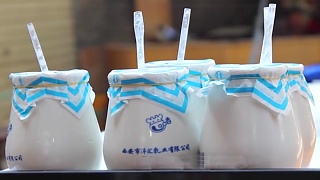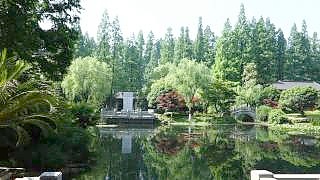
|
ShaanXi province.
Street food, Xiǎo Chī (small eats), 火锅 in the Muslim Quarter ...
From film-maker Kevin Cook :
For Xi'an, the old Silk Road trade route opened the doors to the culinary influence of other cultures, particularly Muslim culture, which is especially evident in the Muslim Quarter in the center of the city. This massive outdoor marketplace of roads and alleyways contains some of the most tasty, unique and interesting street foods in all of China.
Shaanxi Sandwich 牛肉夹馍 (Niúròu jiā mó) - 8 RMB
The first street food that I eat in this video is Nui Rou Jia Mo (beef sandwhich). Due to its origins in the Shaanxi Province, it’s often called the “Shaanxi Sandwich.”
Mutton soup with bread 泡馍 (Pào mó) - 38 RMB
This one isn't so much a street food as it is a full meal in a bowl. Pao mua is mutton soup with bread, and it requires a little bit of work to prepare. It's one of the hardiest dishes you can eat in Xi’an, and it’s absolutely amazing. For 38 Yuan, it’s more expensive than most dishes you’ll find around here, but it’s worth it.
Street Yoghurt 酸奶 (Suānnǎi) - 8 RMB
Sua nai, which literally means “sour milk,” is a sweet yoghurt drink sold in little white cups, and it’s especially satisfying on a hot day like today.
Beef jerky 牛肉干 (Niúròu gān) Price varies per kilo
Niu roy gan, or dried beef, is another delicious street snack available in all parts of the Muslim market place. Unlike similar looking beef jerky in the west, the variety that I bought in Xi'an has a much more distinct meaty flavor than any other beef jerky I’ve ever eaten.
Bread 楠 (Nán) - 5 RMB
Hailing originally from the XinJiang Province is a hardy flat bread that's sold all over Xi’an. The Uyghur people who bake this bread call it 'nan,' but Han Chinese call it 'nang.'
Skewered mutton 羊肉串 (Yángròu chuàn) 10 RMB/2 skewers
Thanks to vendors like the one in this video, the tempting aroma of juicy grilled meat permeates the entire marketplace. This snack is dripping with fat and seasoned to perfection, making this a rich, hardy Xi'an street snack.
Peanut Candy 花生糖 (Huāshēng táng) - 20 RMB/box
A few varieties of this sweet snack are available, and each requires an interesting method of preparation, such as pounding the candy with a mallet and stretching it out over a hook. The process of making this delicious street treat is even more fun to watch than it is to eat.
The beautiful Xi'An Expo park and Hot Pot, huǒ guō, 火锅 ...
Bonus film - hand-pulled noodles
From the Food Ranger, Trevor James :
Hand pulled noodles are found everywhere in China. These hand pulled noodles were so delicious, simply some of the best Chinese food you can have in all of China. They are featured in LanZhou LaMian restaurants everywhere.
Lanzhou LaMian AKA LanZhou hand pulled noodles are everywhere, and each restaurant has a very similar menu. These restaurants are usually very good for foreigners in China because they often have a huge picture menu all over the walls, so you can just point at what you think looks good. In this video, me and my local friend try two very amazing dishes : the DaPanJi, also known as the XinJiang big plate of beef, and then my other favorite noodle dish, the lamb and cumin on top of hand pulled noodles. These two dishes combined made a massive meal for two people.
So if you're a foreigner living in China or if you're just traveling in China for a short time, visiting a LanZhou hand pulled noodles restaurant is a MUST!
|







 Ukraine, Russia, Sri Lanka, Thailand, China and Japan – update, July 15th 2022
Ukraine, Russia, Sri Lanka, Thailand, China and Japan – update, July 15th 2022





















![`US-sponsored separatist groups, backed by Washington for decades, are being mobilized to attack and undermine activities related to the BeiJing 2022 Olympics, starting with the torch relay in Greece. I explain the background of the “Free Tibet” movement and how the US government, through the CIA, backed it as early as the 1950s and transferred its operations to the National Endowment for Democracy (NED) [or `Dominion` / enslavement]. ` With The New Atlas . . . Bonus films - terror activities by US-backed `opposition` in Myanmar . . . Bonus film 2 - subverting the `left` . . . Bonus film 3 - on Ecuador . . . Bonus film 4 - on Cambodia . . . They say : `How dare you put your face in front of my fist ! Serve your master. Or else. ` More . . . On the US plan to nuke Chinese cities - as revealed by Daniel Ellsberg, famous for the `Pentagon Papers`, with NuMuves . . . On the Falun Gong cult . . . *** Planning war on China - part 11 - don't miss it ***](https://img.youtube.com/vi/2w31eNNcGVU/mqdefault.jpg)









![Quote (from the BBC `news` website, 19th February 2023) : `Meanwhile, friends of the detainees [supposedly lockdown protesters], anxious and worried for their own personal safety, continue to keep tabs on the situation and share information. Many of them live overseas and did not attend the November protests . . . [about saving lives with lockdowns]. ` The lockdowns might have been over the top, but doubtless saved many lives - so that is a matter of debate; and the `protesters` might have had some good arguments [one might say], but the key thing here is whether in reality it was all a Western attempt at subverting China; and if one looks at other articles around the same time / leading up to these `protests` [greatly exaggerated], that seems to indeed be the case. Again, in the BBC`s own words : Many of them LIVE OVERSEAS. In the BBC`s own words : Many of them LIVE OVERSEAS. LIVE OVERSEAS. This is a very important point to keep in mind : these people were not there, but somehow have something to say, and their `not even there` tale is being pushed by MSM. It is the XinJiang / HK scam repeated over, and over, and over again. Who are these people and who do they work for ? [Well hidden of course] Not knowing these facts, why trust them ??? Enough of the BBC - they have no credibility; we are not going to do this every day [when see excrement, step over it, it is not worth analysing]; the lies are easy to spot, if you look. Open your eyes . . . And always remember that propaganda is the first move in war - demonise your `enemy` [everyone `else`]. While frustration can be understood, covert agendas [and foreign recruits?] are another thing. For sure, though, the `daily hate` will continue; and shame on them. *** Once the venom is extracted, the disease is cured. *** Bonus film - the US spent millions of dollars shooting down $12 hobby balloons . . . A thought on the latest BBC's daily China hate article](https://img.youtube.com/vi/1EFiAy8THFA/mqdefault.jpg)







